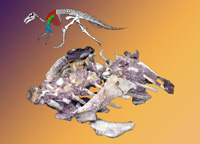
A few large fragments of dinosaur bones were excavated in Bosong, South Jeolla Province, the first time such substantial relics have been found in Korea. Huh Min, a professor at the Korea Dinosaur Research Center of Chonnam National University, estimated the reptile inhabited the shore in the southwestern region about 83 million years ago. The fossil was conserved with its perfect shape and the significance of the find arises from its rarity.
The Cultural Heritage Administration (Administrator Yoo Hong-joon) and the Korea Dinosaur Research Center (Director: Prof. Huh Min) at CNU held a briefing session of the excavation at the Bosong county office at 2 p.m., Wednesday, October 13. A dinosaur fossil expedition has excavated a rare, perfectly-shaped dinosaur bone at the seashore of Deukryang-myon, Bosong-gun County.
To date, a great number of dinosaur fossils have been found in Korea. However, this is the first time to unearth well-preserved dinosaur fossils with its original shapes. The discovery of a valuable dinosaur fossil is estimated as a significant clue to unveil what species of dinosaurs lived in the Korean Peninsula during the Cretaceous period and the relationship with the fossilized dinosaur eggs found in Bosong.
"A dinosaur fossil expedition sponsored by the Cultural Heritage Administration, Jeonnam Provincial Office, and Bosong-gun has excavated a new, rare dinosaur bone fossil at the seashore of Deukryang-myon, Bosong-gun. Through the preparation and the comparative analysis with the dinosaur fossils found in China, Mongolia, and the United States, this creature is estimated as a new species of plant-eating dinosaurs," said Prof. Huh Min, taking in charge of the Korea Dinosaur Research Center.
A relatively complete section of the whole body shapes were found and fully articulated with scapulas, humerus, coracoid, sternum, dorsal vertebra, and ribs. It is expected that the excavating team would obtain more valuable fossils as the expedition goes on at the site.
Dinosaur footprints and some smaller bone parts have been dug up in the peninsula in the past, but the fragments were not complete enough to establish which species they were from, researchers said. "The bones look as if they belong to a hadrosaurus," the research team said. The hadrosaurus is a herbivorous species from the late Cretaceous period. It roamed East Asia 80 million years ago."But the bones are bit thicker and wider than a normal hadrosaurus, so it might turn out to be a completely new species," the experts added. The team has identified a shoulder blade, upper parts of the fore legs, and eight segments of the creature's spine, along with nine rib segments. The creature would have been about 2 meters long. The team presumes it was not over a year old. In the same general area, the team discovered 15 nests containing about 130 dinosaur eggs. The "duck-billed dinosaurs" were common in the Upper Cretaceous of Europe, Asia, and North America. They were members of the Ornithopoda, and close relatives and possibly descendants of the earlier iguanodontid dinosaurs. Early interpretations of fossil skin impressions suggested that hadrosaur feet were webbed. Recent hypotheses, more consistent with what we know about the structure of ornithopod feet, suggest that hadrosaurs had pads similar to those seen on camel feet. Their stiff tails, supported by ossified tendons, and their sturdy bones and rapidly-replaced teeth suggest that hadrosaurs spent most of their time on land, though close to bodies of water, feeding on tough terrestrial plants. The discovery of spectacularly preserved hadrosaur nests and young shows that hadrosaurs migrated to nesting grounds to reproduce.
The Korea Dinosaur Research Center has been collaborating with Dr. Kenneth Carpenter working at the Denver Museum of Natural History for a new research project, examining turtle bone; turtle egg fossils, meat-eating dinosaurs, and pterosaurs. When the joint research completes, the 80 million-year-ago mystery of these animals' coexistence can be revealed.
The Korea Dinosaur Research Center has led the research activities on dinosaurs in Korea, of dinosaurs, which lived around Sado Island and other small islands nearby (Chudo, Nangdo, Jeokgeumdo, and Mokdo). About 3,800 fossils were unearthed in the area, which is said to be the largest site of dinosaur footprints in Korea. The fossils are believed to be from the latter half of the Cretaceous period of the Mesozoic era, dating back some 80 to 90 million years ago.